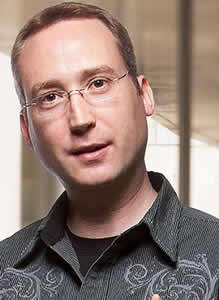
April 24, 2017
LA JOLLA—Two Salk Institute faculty members have been promoted based on their innovative and notable contributions to biological research.
Janelle Ayres and Axel Nimmerjahn were each promoted to the rank of associate professor. The promotions were based on recommendations by Salk faculty and nonresident fellows, and approved by President Elizabeth Blackburn and the Institute’s Board of Trustees on April 21.
“Janelle and Axel are among the new generation of scientists who use innovative tools and strategies to explore the important fields of microbiome science and neurobiology,” says Blackburn. “We are very fortunate to have young scientists of their caliber calling Salk home.”


Ayres, who conducts research in the Nomis Foundation Laboratories for Immunobiology and Microbial Pathogenesis, studies how the body controls and repairs the collateral damage generated during interactions with harmful microbes. She is taking an innovative approach grounded in mathematical and evolutionary predictions that uses the beneficial microbes inhabiting our digestive system for damage-control therapeutics. In pivotal work, Ayres showed that those damage-control mechanisms are just as important as an animal’s immune system in surviving infection. Her revelation of an entirely new set of defense mechanisms will likely lead to novel therapies that bacteria won’t be able to evolve resistance to (unlike antibiotics). Ultimately, by leveraging those damage-control mechanisms, Ayres aims to develop new and effective treatments for infectious and non-infectious diseases, such as pathologies associated with cancer and aging. Read about her latest groundbreaking results here.
Nimmerjahn, who is a member of the Waitt Advanced Biophotonics Center, develops and uses novel imaging approaches to explore the role of glial cells, which carry out critical activities in the central nervous system such as sensing and minimizing damage. Recently, he traced changes in the tight junctions between the cells lining the brain’s blood vessels, providing insights into the breakdown of the blood-brain barrier in stroke patients. He identified regulators that enable glial cells to effectively clear dying neurons thereby facilitating regeneration, and he uncovered mechanisms that control glial immune responses to viral infection, described here. His tiny microscopes (weighing only about 2 grams) allowed him to visualize pain-related glial cell and neuronal activity in the spinal cord of freely behaving animals. Using cutting-edge imaging tools to resolve such questions has broad implications for our understanding of the central nervous system and the treatment of neuroinflammatory and neurological disorders.
Office of Communications
Tel: (858) 453-4100
press@salk.edu
Unlocking the secrets of life itself is the driving force behind the Salk Institute. Our team of world-class, award-winning scientists pushes the boundaries of knowledge in areas such as neuroscience, cancer research, aging, immunobiology, plant biology, computational biology and more. Founded by Jonas Salk, developer of the first safe and effective polio vaccine, the Institute is an independent, nonprofit research organization and architectural landmark: small by choice, intimate by nature, and fearless in the face of any challenge.